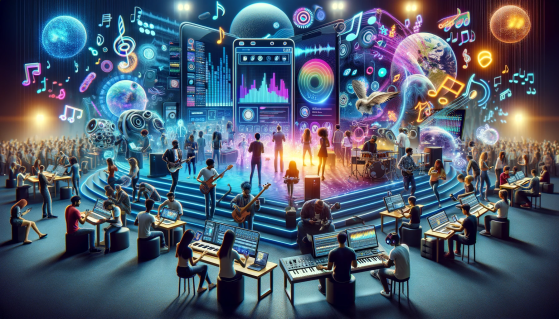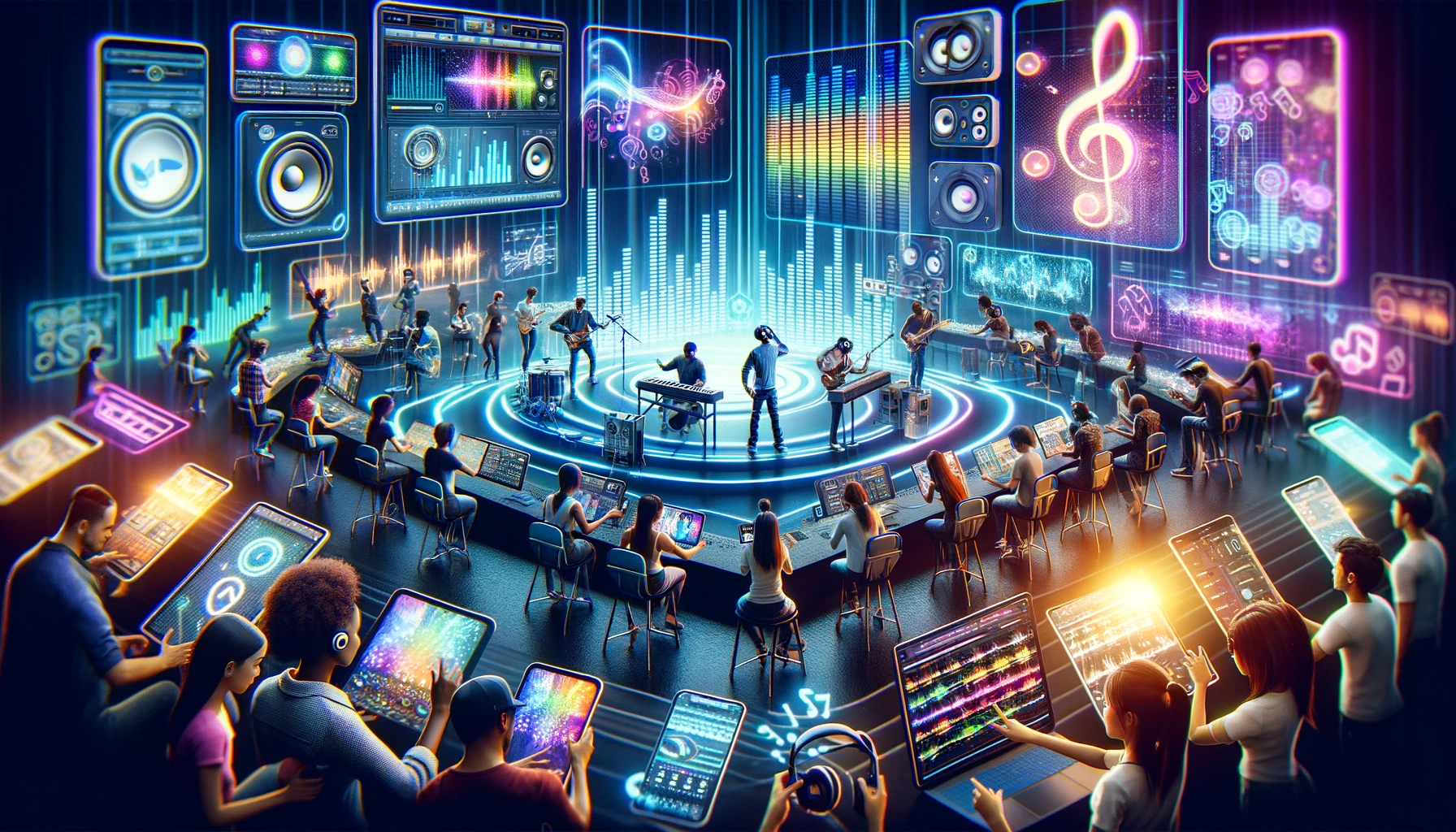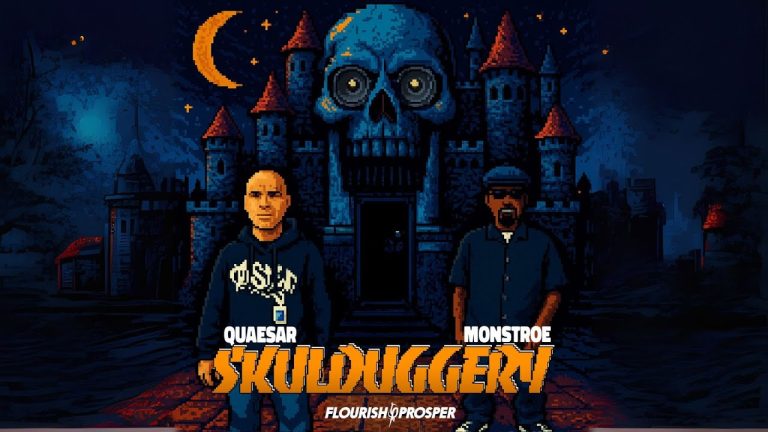Emerging Trends in Augmented Reality (AR) Music Applications
Integration of AR into Music Apps
One of the significant emerging trends in augmented reality music apps is the incorporation of AR features into existing music platforms. This trend is exemplified by companies like Spotify and Apple Music integrating AR technology, providing a unique experience where fans can view 3D holograms of musicians, access exclusive content, or participate in immersive album promotions. This integration has opened up a new way of interacting with music, moving beyond the auditory to provide a multisensory engagement.
AR-powered Live Shows and Concerts
The advent of AR is revolutionizing the way we experience live music. With AR-enabled mobile apps, concertgoers can enjoy performances from their favorite artists enhanced with stunning visuals and soundscapes that traditional performances cannot provide. For example, app users can experience virtual concerts at the comfort of their homes or transform their surroundings into a concert-like setting. The use of AR in concerts and events also solves various logistical issues, leading to a more seamless experience for spectators.
Use of AR in Music Education
Augmented reality is also making significant strides in music education. AR-based music applications offer an immersive learning experience, enabling users to visualize and interact with musical elements. For instance, AR can make learning instruments more engaging by simulating a tutoring session or displaying chords and notes over a real instrument. Such applications are particularly useful for distance learning and self-teaching, catering to the learners’ personal pace and style.
How Interactive Music Apps are Revolutionizing the Music Industry
Transforming the Musical Landscape with Interactive Apps
Interactive music applications are setting a new trend in the music industry by offering enhanced listener engagement and unprecedented accessibility. These applications go beyond the typical streaming of songs, by integrating features like live concerts, virtual reality immersions, and real-time interaction with artists. This innovative approach enhances the overall fan experience and adds unique value to musical content.
The success of these applications can be attributed to the digital revolution which has made music available at our fingertips. With interactive music apps, fans can do more than just listen – they can actively participate, making the music experience more personalized and engaging.
Tailoring the Fan Experience
One key feature that sets interactive music apps apart from traditional music platforms is the ability to customize the fan experience. Listeners can create their own musical journey by choosing from a variety of genres, artists, or specific songs. Some apps also allow fans to remix tracks and share them with the online community, thereby offering a platform for creativity and innovation.
Moreover, interactive features like virtual reality (VR) and augmented reality (AR) concerts give users the feeling of standing right next to their favourite artists on stage. This advanced tech-infused experience is revolutionizing the entire concept of live concerts.
Boosting Artist-Fan Interaction
In addition to enhancing the fan engagement, interactive music apps are opening up new avenues for artists to connect with their audience. These platforms enable artists to host live chats, share updates on new releases, or even collaborate with fans on new tracks.
Also, these apps empower independent musicians by giving them a platform to showcase their talent beyond geographical boundaries. By doing so, they democratise the music industry, encouraging diversity, and fostering a culture of musical innovation.

The Intersection of Augmented Reality and Interactive Music Apps
Transforming Musical Engagement with Augmented Reality
Augmented reality (AR) is an innovative technology that enhances user experiences by adding digital information—like visuals, audio, or other sensory enhancements—into the real world. When this technology intersects with interactive music apps, it elevates the fan experience to an entirely new level.
Music apps have already revolutionized how we listen to and interact with music, allowing fans not just to listen to their favorite songs, but also to create their own music, learn about artists, and even attend virtual concerts. AR further expands these possibilities by enabling more immersive and engaging interactions. For instance, AR can allow fans to virtually step into a music video, interact with artists in a simulated environment, or play virtual, interactive instruments, thus augmenting traditional music consumption models.
Building Enhanced Interactivity with AR Music Apps
Elements of augmented reality incorporated within music apps can offer enhanced interactivity. For instance, some well-known music streaming platforms utilize AR features to provide a visually immersive experience, turning passive listening into a dynamic visual and auditory spectacle. Another application of AR in music apps is through interactive music learning. Here, AR can make playing a musical instrument a more enjoyable and engaging process by providing real-time guidance, feedback, and scoring.
AR can also give fans unprecedented access to their favorite artists. Fans can use AR-fueled apps to interact with lifelike avatars of these artists, even going so far as to stage virtual mini-concerts in their living rooms. This degree of interactivity, previously unattainable, is changing the way fans engage with artists and their music.
The Future of AR and Interactive Music Apps
The intersection of AR and interactive music apps is still a relatively new field with immense potential for growth. As technological advancements continue, the integration of these two fields is poised to become more seamless, giving birth to a range of immersive and interactive experiences previously unimaginable.
This convergence is already transforming the music industry and altering how fans connect with music. With the ever-increasing availability of AR technologies and the proliferation of smart devices, the future of AR-infused interactive music apps holds promising prospects for fans, artists, and the music industry as a whole. These advancements may well offer fans an even more intimate, involved, and interactive musical experience.
User Interactivity Enhancement with AR in Music Applications
Augmented Reality (AR) has the potential to redefine how music apps engage users, providing an immersive and interactive experience. With AR, music fans get an opportunity to not only listen to music but also interact with it in unique ways.
Engaging Visual Elements with Music
The first step towards enhancing user interactivity in music applications is the incorporation of engaging visual elements in tandem with music. This allows users to participate in a multisensory experience rather than just consuming audio content. This transformative approach translates into users feeling the rhythm, beats, and melody in a visually appealing environment. Musicians and bands can create AR music videos or live performances, offering fans ‘inside the song’ experiences. Examples of such applications include Gorillaz’ AR app, where fans could explore the band’s house in AR while listening to their tunes.
Interactive Learning Experience
The second aspect focuses on learning and creativity. Educational music apps can employ AR to provide interactive sheet music and tutorial videos. Users can learn how to play various instruments or sing different songs effectively by interacting with AR tutorials, which show them the correct techniques and allow for real-time error adjustment. An example of this is the AR piano learning app, Piano 3D, which guides users through interactive lessons.
Social Interactivity and Collaboration
Lastly, AR can foster social interactivity and collaboration among users. This can be achieved by creating shared spaces where users can interact, play, and learn from each other in a virtual environment. Fans can attend virtual concerts together or collaborate on music compositions, fostering a sense of community and shared experiences. Applications like SoundStage VR, offer a virtual reality space where users can create and share their own music.
In conclusion, AR technology presents an exciting avenue for developing more interactive and engaging music applications. Through AR, users can enjoy a more immersive music experience, enriched learning opportunities, and enhanced social interactivity.
Music Fans Engagement: A New Era driven by AR and Interactive Apps
The Advent of AR and Interactive Apps in Music Fandom
The landscape of music fandom has experienced significant change, driven primarily by the advent of Augmented Reality (AR) and interactive applications. AR technology has been leveraged to provide a new dimension of interaction between artist and audience, creating immersive experiences that extend beyond the traditional barriers of music enjoyment. Whether it’s attending virtual concerts or participating in interactive music video experiences, audiences are given a unique opportunity to engage with their favorite artists and music in unprecedented ways.
Driving Engagement Through Unique Experiences
The power of AR in driving fan engagement lies in its ability to create unique experiences. For instance, apps can offer AR filters inspired by popular songs or artist personas, which fans can use in their own content creation, promoting organic sharing and interaction. Beyond this, apps such as Spotify are pioneering methods to augment the listening experience with storytelling elements. These might include liner notes, lyrics trivia, or behind-the-scenes insights, all accessible within the app and enhancing the overall engagement with the music.
Interactive Apps: Facilitating Connection and Community
Interactive applications play a crucial role in facilitating connection and fostering community among music fans. Fan communities can organize virtual meetups, participate in exclusive events, and engage in activities geared towards enhancing their understanding and enjoyment of their favorite musicians. The potential for personalizing the user experience is substantial, as these apps can analyze individual listening behavior to deliver customized recommendations and unique insights into the music they love. In this digital era, interactive apps are reshaping the way music fans engage with their favorite artists, fostering a closer, more interactive relationship.
Prospects and Challenges of AR in Developing Interactive Music Apps
Potential Advancements with AR in Interactive Music Apps
AR technology in interactive music apps presents an array of interesting prospects, providing new dimensions to user engagement and offering experiential opportunities unlike any other. Users can dive into a more engaging, immersive musical experience that transcends conventional listening. For instance, AR can bring artists and fans closer by allowing them to interact within the same digital space. This technology could also be instrumental in driving music education forward, such as AR-guided instrument tutorials and real-time feedback sessions.
Additionally, AR can heighten emotional responses by augmenting live performances with visual effects tied to the rhythm and mood of the songs. It can also offer more personalized experiences, with users being able to customize their listening environment. A fan could, for instance, have their favorite musician perform a personal concert right in their living room.
Obstacles in Incorporating AR into Music Applications
Despite these promising prospects, there are also a number of challenges to integrating augmented reality into interactive music apps. One primary obstacle is the need for substantial technological infrastructure. AR experiences require robust, high-speed internet connections and high-end devices to function seamlessly, elements that might not be readily accessible to some users.
Furthermore, creating AR content is complex and requires significant resources. The cost of producing such content and the lack of skilled professionals who can develop AR-enabled apps is another hindrance. Also, designing intuitive and user-friendly interfaces for AR music apps can be demanding due to the novelty of the technology and the need to accommodate diverse user expectations.
Navigating User Privacy Concerns
Another significant challenge of incorporating AR in music apps is navigating user privacy concerns. Given that AR technology often requires access to users’ cameras and location data, there are serious questions around data privacy and security. Companies will need to strike a balance between creating engaging AR experiences and ensuring users’ personal data is secure. For AR in music apps to be truly successful, it will require transparent privacy policies and user trust.
Case Studies of Augmented Reality and Interactive Music Apps Success Stories
Exploring Augmented Reality through Gorillaz App
The band Gorillaz took the music world by storm with their inventive use of Augmented Reality (AR) in their app. Prior to the release of their album “Humanz”, they launched an app that allowed fans to ‘step inside’ the world of Gorillaz for the first time. The AR experience invited users to explore the band’s house and discover new music, interviews, and other multimedia content in a fully immersive way. It was a game-changer in the industry, providing fans with a unique, interactive way to connect with music.
A New Beat: Inception and Sigur Rós’s Interactive Collaboration
Another brilliant example of AR and interactive music apps is the collaboration between the immersive media startup Inception and Icelandic post-rock band Sigur Rós. Together, they launched an app called “Tonandi”, which translates the band’s sonic landscape into a series of dreamlike, interactive visuals. The app uses AR and spatial audio to place users inside a reactive, audio-visual environment. Each sound in this environment corresponds to elements in Sigur Rós’s music, creating complex, dynamic compositions that users can explore, manipulate, and play.
Enhancing Performance with Childish Gambino’s PHAROS AR
Childish Gambino’s PHAROS AR app showcased a new level of entertainment by bridging the gap between physical and virtual performance. This app transported fans into a virtual concert space where they could experience the artist’s performances in a cosmic setting. The unique factor here was not just the translation of the concert into AR, but also pointing towards a new direction for artists to make big performances more accessible to fans worldwide via technology. This innovative approach to music distribution and consumption intensely extends the fan experience beyond traditional boundaries.




